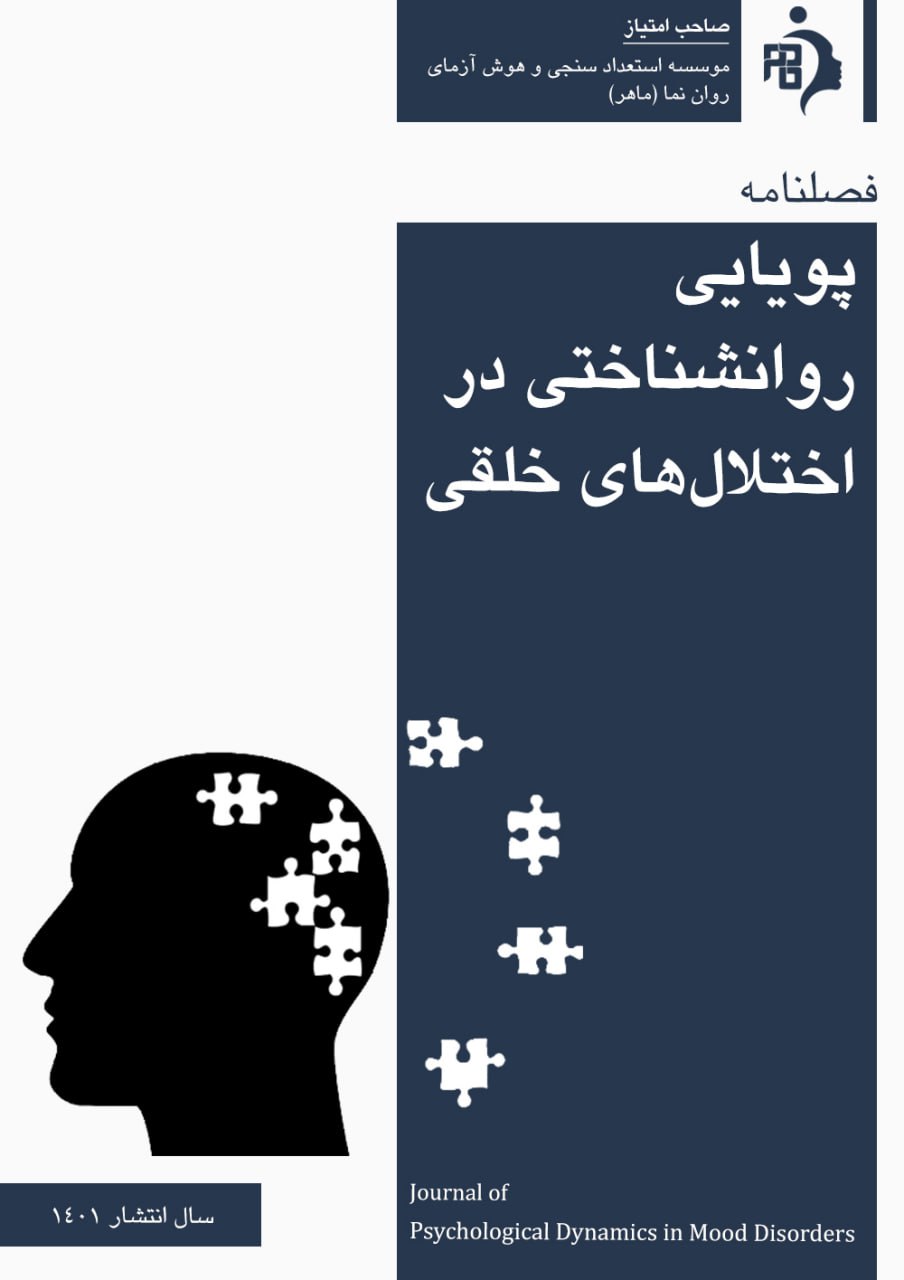Prediction of Self-Harm Behaviors in Women Based on Experience of Violence, Self-Differentiation, and Cognitive Regulation Strategies
Keywords:
Differentiation , Self-Harming Behaviors, Violence Experience, Cognitive Regulation Strategies, DifferentiationAbstract
Objective: The aim of this study was to predict self-harm behaviors in women based on their experience of violence, self-differentiation, and cognitive regulation strategies.
Methodology: This research was applied in terms of its objective and classified as descriptive-correlational in terms of its method and nature. The study population consisted of women visiting health service centers of the Welfare Organization. Based on the formula by Tabachnick and Fidell, 148 participants were selected as the sample using purposive sampling. For data collection, the following questionnaires were used: the Self-Differentiation Scale (2011), the Cognitive Emotion Regulation Questionnaire by Gross and John (2003), the Violence Experience Measure for Women by Hajyahi (1999), and the Self-Harm Behaviors Scale by Sanson et al. (1998).
Findings: The results showed that experience of violence (β = 0.207), self-differentiation (β = -0.248), and cognitive regulation strategies (β = -0.213) were significant predictors of self-harm behaviors in women. Among the components of these variables, sexual violence (β = 0.385), enmeshment with others (β = 0.272), and cognitive reappraisal (β = -0.152) had the highest impact on self-harm behaviors in women.
Conclusion: To reduce social harm, it is recommended that educational institutions related to family mental health pay more attention to the role of women, who are responsible for raising the next generation.
Downloads
References
Abbasi Abrazgah, M., Bostansara, M., & Aghighi Ravan, F. (2024). The Model for Predicting Self-Harming Behaviors Based on Cognitive Emotion Regulation Strategies and Emotional Distress Tolerance in Adolescents Visiting Harm Reduction Centers in Tehran: The Mediating Role of Internalized Shame. Applied Family Therapy Journal (AFTJ), 5(5), 164-172. https://journals.kmanpub.com/index.php/aftj/article/view/3527
Ahmadi, M., Mir Hosseini, H., & Monirpour. (2019). A Predictive Model of Self-Injurious Behaviors and Suicidal Tendency Based on Attachment Styles and Personality Organization in Adolescent Students: The Mediating Role of Cognitive Emotion Regulation Strategies. Quarterly Journal of Applied Psychological Research, 10(3), 101-117. https://japr.ut.ac.ir/article_73873.html
Ali, P. A., & Abul-Fotouh, O. P. (2021). Intimate partner violence and its association with sociodemographic factors: a cross-sectional study among women in Alexandria, Egypt. BMC Women's Health, 21(1), 1-9. https://pubmed.ncbi.nlm.nih.gov/25392386/
Babakhanlou, A. (2023). Presenting Structural Model of Emotional Eating in People with Obesity based on Self-Regulation with the Mediating Role of Emotional Processing. Journal of Psychological Dynamics in Mood Disorders (PDMD), 2(2), 30-40. https://doi.org/10.22034/pdmd.2023.185859
Baetens, I., Claes, L., Martin, G., Onghena, P., Grietens, H., Van Leeuwen, K., & Griffith, J. W. (2014). Is nonsuicidal self-injury associated with parenting and family factors? The Journal of Early Adolescence, 34(3), 387-405. https://doi.org/https://doi.org/10.1177/0272431613494006
Besharat, M. A., Ofoghi, Z., Aghaei Sabet, S., Habib Nejad, M., Pournaghdali, A., & Geranmayehpour, S. (2016). The Moderating Role of Cognitive Emotion Regulation Strategies in the Relationship Between Alexithymia and Interpersonal Problems. New Advances in Cognitive Sciences, 15(4), 43-52. https://icssjournal.ir/browse.php?a_id=216&sid=1&slc_lang=fa
Caron, A., Lafontaine, M. F., & Bureau, J. F. (2018). Exploring the relationship between child maltreatment, intimate partner violence victimization, and self-injurious thoughts and behaviorsJO - Journal of Aggression, Maltreatment & Trauma. 27(7), 759-776. https://doi.org/https://doi.org/10.1080/10926771.2017.1410746
Chisholm, J. F., Bullock, L., & Ferguson, A. (2021). Healing pathways: A randomized controlled trial examining a cognitive-behavioral intervention for survivors of intimate partner violence. Clinical Psychology & Psychotherapy, 28(2), 587-597.
Devkota Sapkota, B., & Simkhada, P. (2024). Domestic Violence Against Women in Nepal: A Systematic Review of Risk Factors. Journal sage. https://doi.org/https://doi.org/10.1177/1524838023122223
Eisenlohr-Moul, T., Divine, M., Schmalenberger, K., Murphy, L., Buchert, B., Wagner-Schuman, M., & Ross, J. (2022). Prevalence of lifetime self-injurious thoughts and behaviors in a global sample of 599 patients reporting prospectively confirmed diagnosis with premenstrual dysphoric disorder. BMC psychiatry, 22(1), 199. https://doi.org/https://doi.org/10.1186/s12888-022-03851-0
Feldman, R. (2023). Developmental Psychology: Development Across the Life Span (From Conception to Childhood). Arjmand Publications. https://doi.org/https://doi.org/10.1037/dev0001523
Garnefski, N., & Kraaij, V. (2014). Relationships between cognitive emotion regulation strategies and depressive symptoms: a comparative study of five specific samples. Personality and individual differences, 40, 1659-1669. https://doi.org/https://doi.org/10.1016/j.paid.2005.12.009
Gross, J. J. (2019). Handbook of emotion regulation. Guilford Press. https://www.iccpp.org/wp-content/uploads/2020/07/Handbook-of-emotion-regulation.pdf
Gross, J. J., & John, O. P. (2003). Individual differences in two emotion regulation processes: Implications for affect, relationships, and well-being. Journal of personality and social psychology, 85, 348-362. https://doi.org/https://doi.org/10.1037/0022-3514.85.2.348
Hashemi, F., Keshavarz, A. H., & Gholamali Lavasani, M. (2022). The Mediating Role of Cognitive Emotion Regulation Strategies in the Relationship Between Domestic Violence, Attachment Styles, and Psychological Well-Being of Women. https://doi.org/https://doi.org/10.18502/qjcr.v21i83.11088
Hosseini, S. A. (2024). Comparison of the Effectiveness of Cognitive Behavioral Therapy and Schema Therapy on Emotional Regulation and Resilience of Mothers with Children with Attention Deficit/Hyperactivity Disorder. Journal of Psychological Dynamics in Mood Disorders (PDMD), 3(1), 12-29. https://doi.org/10.22034/pdmd.2024.442238.1045
Jafarzadeh, T., Soleimanian, A. A., & Mohammadipour, M. (2021). Predicting Domestic Violence Based on Family Functioning and Level of Self-Differentiation with the Mediating Role of Alexithymia in Women Referring to Comprehensive Health Service Centers in Bojnord. Scientific Quarterly Journal of Learning and Instruction Research of Azad University of Bojnord, 65(16), 59-78. https://journals.iau.ir/article_678719.html
Jawarkar, A., Shemar, H., Wasnik, V., & Chavan, M. (2016). Domestic violence against women: a crossectional study in rural area of Amravati district 065 of Maharashtra, India. International Journal of Research in Medical Sciences, 4(15), 2713-2718. https://doi.org/https://doi.org/10.18203/2320-6012.ijrms20161937
Johnson, K. A. U. B. I., & Walton, E. (2021). Cognitive-behavioral interventions with female survivors of intimate partner violence: a systematic review and meta-analysis. Trauma, Violence, & Abuse, 22(3), 450-467.
Johnson, P. (2022). Childhood experience of violence and its impact on self-harming behaviors in adolescent girls: The moderating role of identity. Child abuse & neglect, 125, 105244.
Keshvari, F., Karbalaei, M., Migouei, A., Rezabakhsh, H., & Pashang, S. (2020). Predicting Anxiety in Adolescent Girls Based on Young's Early Maladaptive Schemas with the Mediation of Self-Differentiation and Daughters' Early Maladaptive Schemas. Quarterly Journal of Applied Psychological Research, 11(4), 93-112. https://jdisabilstud.org/article-1-3061-fa.html
Kisa, S., Gungor, R., & Kisa, A. (2023). Domestic Violence Against Women in North African and Middle Eastern Countries: A Scoping Review. Journal sage, 24(2). https://doi.org/https://doi.org/10.1177/15248380211036070
Macklem, G. L. (2018). Practitioner's guide to emotion regulation in school-aged children. Springer Science & Business Media. https://download.e-bookshelf.de/download/0000/0021/85/L-G-0000002185-0002367720.pdf
Messedi, N., Feki, I., Masmoudi, R., Saguem, B. N., & Masmoudi, J. (2017). What relationship between eating disorders and alexithymia among medical students? European Psychiatry, 41(S1), S557. https://doi.org/https://doi.org/10.1016/j.eurpsy.2017.01.799
Nikdel, B., Naderi, F., & Ehteshamzadeh, P. (2021). Investigating the Mediating Role of Meaning of Life in the Relationship Between Depression and Family Emotional Climate with Suicidal Ideation in Women with Substance Dependence. Quarterly Journal of Applied Psychological Research, 12(4), 117-138. https://japr.ut.ac.ir/article_85827.html
Nock, M. K. (2010). Self-injury. Annual Review of Clinical Psychology, 6(1), 339-363. https://doi.org/https://doi.org/10.1146/annurev.clinpsy.121208.131258
Parsakia, K., Farzad, V., & Rostami, M. (2023). The mediating role of attachment styles in the relationship between marital intimacy and self-differentiation in couples. Applied Family Therapy Journal (AFTJ), 4(1), 589-607. https://doi.org/10.61838/kman.aftj.4.1.29
Roberts, C. L., & Symons, F. (2024). Self‐injurious behavior in individuals with intellectual and developmental disabilities: An interdisciplinary family systems review. Journal of Family Theory & Review, 16(2), 329-351. https://doi.org/https://doi.org/10.1111/jftr.12548
Röcke, C., Brose, A., & Kuppens, P. (2018). Emotion dynamics in older age. In (pp. 207). https://doi.org/https://doi.org/10.4324/9781351001328-9
Roghani, F., Sa'adati Shamiri, A., Abdollahpour, A., & Hashemi, N. (2024). The Effectiveness of the Psychological-Educational Intervention Package of Fluid Intelligence on Emotional Cognitive Regulation in Children with Attention Deficit Hyperactivity Disorder. Psychological Dynamics in Mood Disorders, 3(2), 189-202. https://doi.org/10.61838/kman.pdmd.3.2.16
Roghani, F., Saadati Shamir, A., Abdollahpour, A., & Hashemi, N. (2024). The Effectiveness of the Skilled Fluid Intelligence Psychological-Educational Intervention Package on Cognitive-Emotional Regulation in Children with Attention Deficit Hyperactivity Disorder. Psychological Dynamics in Mood Disorders, 3(2), 189-202. https://doi.org/10.61838/kman.pdmd.3.2.16
Salam, R., Lassi, Z. S., Das, J. K., Bhutta, Z. A., Hadi, Y. B., Sansone, R. A., Wiederman, M. W., & Sansone, L. A. (2021). Interventions to prevent gender-based violence against adolescent and adult women living with HIV/AIDS in low-and middle-income countries: a systematic review The Self-Harm Inventory (SHI): development of a scale for identifying self-destructive behaviors and borderline personality disorder. AIDS care, 33(4), 459-470. https://doi.org/https://doi.org/10.1002/(SICI)1097-4679(199811)54:7<973::AID-JCLP11>3.0.CO;2-H
Shabahang, R., Besharat, M. A., & Nikoraftar, M. (2019). The Role of Cognitive Flexibility and Emotion Regulation Difficulties in Predicting Celebrity Worship Among Students. Knowledge and research in applied psychology, 26(1). https://www.sid.ir/paper/163872/
Shahbazi Rad, A., & Mohammadi, F. (2021). The Role of Cognitive Emotion Regulation Strategies and Irrational Thoughts in Predicting Suicidal Ideation in Women with Substance-Dependent Spouses. Addiction Research, 15(61), 167-180. https://doi.org/https://doi.org/10.52547/etiadpajohi.15.61.167
Shuman, V., & Scherer, K. R. (2015). Emotions, psychological structure. In (Vol. 1, pp. 526-533). https://doi.org/https://doi.org/10.1016/B978-0-08-097086-8.25007-1
Son, Y., Kim, S., & Lee, J. S. (2021). Self-injurious behavior in community youth. International journal of environmental research and public health, 18(4), 1955. https://doi.org/https://doi.org/10.3390/ijerph18041955
Taheri Fard, M., & Mikaeili, N. (2019). The Effectiveness of Mindfulness-Based Cognitive Therapy on Social Anxiety, Resilience, and Emotion Regulation in Women Victims of Domestic Violence. Journal of Thought and Behavior, 60, 10-25. https://www.sid.ir/paper/172057/fa
Tajeryan, Z., Afrooz, G. A., & Nouryghasemabadi, R. (2023). Emotion Regulation in Women with PTSD and Addiction. Psychology of Woman Journal, 4(2), 160-168. https://doi.org/10.61838/kman.pwj.4.2.19
Wang, X. C., Yang, X. D., Liu, X. M., Wang, Q. L., Zhang, S. J., Zhu, C. Y., & Xiao, Y. H. (2020). Association between physical punishment and adolescent mental health in China: Evidence from a cross-sectional survey. Epidemiology and Psychiatric Sciences, 29, e141.
Zadnik, V., Sabolčec, V., & Ajduković, M. (2021). Intimate partner violence against women in Croatia: prevalence, risk factors, and health consequences. Croatian Medical Journal, 62(1), 32-40. https://journals.plos.org/plosone/article?id=10.1371/journal.pone.0295340









